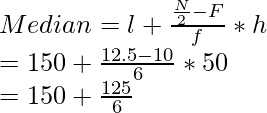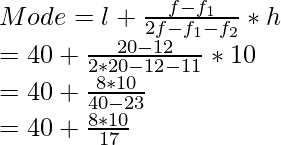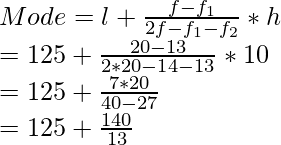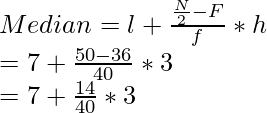Class 10 RD Sharma Solutions – Chapter 7 Statistics – Exercise 7.5 | Set 2
Last Updated :
05 Mar, 2021
Question 11. Find the mean, median, and mode of the following data:
| Classes | 0-50 | 50-100 | 100-150 | 150-200 | 200-250 | 250-300 | 300-350 |
| Frequency | 2 | 3 | 5 | 6 | 5 | 3 | 1 |
Solution:
Let mean (A) = 175
| Classes |
Class Marks
(x)
|
Frequency
(f)
| c.f. |
di = x – A
A = 175
| fi * di |
| 0-50 | 25 | 2 | 2 | -150 | -300 |
| 50-100 | 75 | 3 | 5 | -100 | -300 |
| 100-150 | 125 | 5 | 10 | -50 | -250 |
| 150-200 | 175-A | 6 | 16 | 0 | 0 |
| 200-250 | 225 | 5 | 21 | 50 | 250 |
| 250-300 | 275 | 3 | 24 | 100 | 300 |
| 300-350 | 325 | 1 | 25 | 150 | 150 |
| Total | | 25 | | | -150 |
Find Median:
Here N = 25, 5/3 = 25/2 = 12.5 or 13, it lies in the class interval = 50-200.
l = 150, F = 10, f = 6, h = 50
Using median formula, we get

= 150 + 20.83
= 170.83
Find Mean:
Using mean formula we get

= 175 – 6
= 169
Find Mode:
Using mode formula we get

= 150 + 25
= 175
Question 12. A student noted the number of cars passing through a spot on a road for 100 periods each of 3 minutes and summarized it in the table given below. Find the mode of the data.
| Number of cars | 0-10 | 10-20 | 20-30 | 30-40 | 40-50 | 50-60 | 60-70 | 70-80 |
| Frequency | 7 | 14 | 13 | 12 | 20 | 11 | 15 | 8 |
Solution:
From the given table we conclude that
Modal class = 40-50 (it has maximum frequency)
Also,
l = 40, f = 20, f1 = 12, f2 = 11 and h = 10
By using mode formula, we get

= 40 + 4.70
= 44.7
Question 13. The following frequency distribution gives the monthly consumption of electricity of 68 consumers of a locality. Find the median, mean, and mode of the data and compare them:
| Monthly consumption(in units) | 65-85 | 85-105 | 105-125 | 125-145 | 145-165 | 165-185 | 185-205 |
| No. of consumers | 4 | 5 | 13 | 20 | 14 | 8 | 4 |
Solution:
Let mean (A) = 135
| Monthly consumption | Class Marks (x) | No. of consumers (f) | c.f. | d = x – A | f.d |
| 65-85 | 75 | 4 | 4 | -60 | -240 |
| 85-105 | 95 | 5 | 9 | -40 | -200 |
| 105-125 | 115 | 13 | 22 | -20 | -260 |
| 125-145 | 135 | 20 | 42 | 0 | 0 |
| 145-165 | 155 | 14 | 56 | 20 | 280 |
| 165-185 | 175 | 8 | 64 | 40 | 320 |
| 185-205 | 195 | 4 | 68 | 60 | 240 |
| Total | | 68 | | | 140 |
Find Median:
Here, N = 34
N/2 = 34,
Class interval = 25-145
Also,
l = 125, F = 22, f = 20 and h = 20
By using the median formula, we get

= 125 + 12
= 137 units
Find Mean:
By using the mean formula, we get
Mean = 
= 135 + 2.05
= 137.05 units
Find Mode:
By using the mode formula, we get

= 125 + 10.76
= 135.76 units
Question 14. 100 surnames were randomly picked up from a local telephone directory and the frequency distribution of the number of letters in the English alphabets in the surnames was obtained as follows:
| Number of letters | 1-4 | 4-7 | 7-10 | 10-13 | 13-16 | 16-19 |
| Number of surnames | 6 | 30 | 40 | 16 | 4 | 4 |
Determine the median number of letters in the surnames. Find the mean number of letters in the surnames. Also, And the modal size of the surnames.
Solution:
Let mean (A) = 8.5
| Number of letters | Class Marks(x) | No. of surnames (f) | c.f. | d = x- A | f.d. |
| 1-4 | 2.5 | 6 | 6 | -6 | -36 |
| 4-7 | 5.5 | 30 | 36 | -3 | -90 |
| 7-10 | 8.5-A | 40 | 76 | 0 | 0 |
| 10-13 | 11.5 | 16 | 92 | 3 | 48 |
| 13-16 | 14.5 | 4 | 96 | 6 | 24 |
| 16-19 | 17.5 | 4 | 100 | 9 | 36 |
| Total | | 100 | | | -18 |
Find Median:
Here, N = 100
So, N/2 = 50
Class interval = 7-10
l = 7, F = 36, f = 40 and h =3
By using the median formula, we get

= 7 + 1.05
= 8.05
Find Mean:
By using the mean formula, we get
Mean = 
= 8.5 + 0.18
= 8.32
Find Mode:
We have,
N = 100
N/2 = 100/2 = 50
Here, the cumulative frequency is just greater than N/2 = 76,
Hence, the median class = 7 – 10
l = 7, h = 10 – 7 = 3, f = 40, F = 36
By using the mode formula, we get
Mode = l + 
= 7 + 
= 7 + 30/34
= 7 + 0.88
= 7.88
Question 15. Find the mean, median, and mode of the following data:
| Class | 0 – 20 | 20 – 40 | 40 – 60 | 60 – 80 | 80 – 100 | 100 – 120 | 120 – 140 |
| Frequency | 6 | 8 | 10 | 12 | 6 | 5 | 3 |
Solution:
| Class interval | Mid value | Frequency (f) | fx | Cumulative frequency |
| 0 – 20 | 10 | 6 | 60 | 6 |
| 20 – 40 | 30 | 8 | 240 | 17 |
| 40 – 60 | 50 | 10 | 500 | 24 |
| 60 – 80 | 70 | 12 | 840 | 36 |
| 80 – 100 | 90 | 6 | 540 | 42 |
| 100 – 120 | 110 | 5 | 550 | 47 |
| 120 – 140 | 130 | 3 | 390 | 50 |
| | | N = 50 | ∑fx = 3120 | |
Find Mean:
By using the mean formula, we get
Mean = 
Find Median:
We have,
N = 50
Then, N/2 = 50/2 = 25
Here, the cumulative frequency just greater than N/2 = 36
Hence, the median class = 60 – 80
l = 60, h = 80 – 60 = 20, f = 12, F = 24
By using the median formula, we get
Median = l + 
= 60 + 
= 60 + 20/12
= 60 + 1.67
= 61.67
Find Mode:
We have,
The maximum frequency = 12
Model class = 60 – 80
l = 60, h = 80 – 60 = 20, f = 12, f1 = 10, f2 = 6
By using the mode formula, we get
Mode = l + 
= 60 + 
= 60 + 40/8
= 65
Question 16. The following data gives the distribution of total monthly household expenditure of 200 families of a village. Find the modal monthly expenditure of the families. Also, find the mean monthly expenditure:
| Expenditure | Frequency | Expenditure | Frequency |
| 1000 – 1500 | 24 | 3000 – 3500 | 30 |
| 1500 – 2000 | 40 | 3500 – 4000 | 22 |
| 2000 – 2500 | 33 | 4000 – 4500 | 16 |
| 2500 – 3000 | 28 | 4500 – 5000 | 7 |
Solution:
From the given table we conclude that
The maximum class frequency = 40
So, modal class = 1500 – 2000
l = 1500, f = 40, h = 500, f1 = 24, f2 = 33
By using the mode formula, we get
Mode = l + 
= 1500 + 
= 1500 + 
= 1500 + 347.826
= 1847.826 ≈ 1847.83
Hence, the modal monthly expenditure = Rs. 1847.83
Now we will find class marks as
Class mark = 
Class size (h) of given data = 500
Let mean(a) = 2750, now we are going to calculate diui as follows:
| Expenditure (In Rs) | Number of families fi | Xi | di = xi – 2750 | Ui | fiui |
| 1000 – 1500 | 24 | 1250 | -1500 | -3 | -72 |
| 1500 – 2000 | 40 | 1750 | -1000 | -2 | -80 |
| 2000 – 2500 | 33 | 2250 | -500 | -1 | -33 |
| 2500 – 3000 | 28 | 2750 | 0 | 0 | 0 |
| 3000 – 3500 | 30 | 3250 | 500 | 1 | 30 |
| 3500 – 4000 | 22 | 3750 | 1000 | 2 | 44 |
| 4000 – 4500 | 16 | 4250 | 1500 | 3 | 48 |
| 4500 – 5000 | 7 | 4750 | 2000 | 4 | 28 |
| Total | 200 | | | | -35 |
From the table we conclude that
∑fi = 200
∑fidi = -35
Mean  = a +
= a + 
= 2750 + 
= 2750 – 87.5
= 2662.5
Hence, the mean monthly expenditure = Rs. 2662.5
Question 17. The given distribution shows the number of runs scored by some top batsmen of the world in one day international cricket matches.
| Runs scored | No. of batsmen | Runs scored | No. of batsmen |
| 3000 – 4000 | 4 | 7000 – 8000 | 6 |
| 4000 – 5000 | 18 | 8000 – 9000 | 3 |
| 5000 – 6000 | 9 | 9000 – 10000 | 1 |
| 6000 – 7000 | 7 | 10000 – 11000 | 1 |
Find the mode of the data
Solution:
From the given table we conclude that
The maximum class frequency = 18
So, modal class = 4000 – 5000
and
l = 4000, f = 18, h = 1000, f1 = 4, f2 = 9
By using the mode formula, we get
Mode = l + 
= 4000 + 
= 4000 + (14000/23)
= 4000 + 608.695
= 4608.695
Hence, the mode of given data = 4608.7 runs.
Question 18. The frequency distribution table of agriculture holdings in a village is given below:
| Area of land (in hectares): | 1 – 3 | 3 – 5 | 5 – 7 | 7 – 9 | 9 – 11 | 11 – 13 |
| Number of families | 20 | 45 | 80 | 55 | 40 | 12 |
Find the modal agriculture holdings of the village.
Solution:
From the given table we conclude that
The maximum class frequency = 80,
So, the modal class = 5-7
and
l = 5, f0 = 45, h = 2, f1 = 80, f2 = 55
By using the mode formula, we get
Mode = l + 
= 5 + 
= 5 + 
= 5 + 
= 5 + 1.2
= 6.2
So, the modal agricultural holdings of the village = 6.2 hectares.
Question 19. The monthly income of 100 families are given as below:
| Income in (in Rs) | Number of families |
| 0 – 5000 | 8 |
| 5000 – 10000 | 26 |
| 10000 – 15000 | 41 |
| 15000 – 20000 | 16 |
| 20000 – 25000 | 3 |
| 25000 – 30000 | 3 |
| 30000 – 35000 | 2 |
| 35000 – 40000 | 1 |
Calculate the modal income.
Solution:
From the given table we conclude that
The maximum class frequency = 41,
So, modal class = 10000-15000.
Here, l = 10000, f1 = 41, f0 = 26, f2 = 16 and h = 5000
Therefore, by using the mode formula, we get
Mode = l + 
= 10000 + 
= 10000 + 
= 10000 + 
= 10000 + 15 × 125
= 10000 + 1875
= 11875
So, the modal income = Rs. 11875.
Share your thoughts in the comments
Please Login to comment...